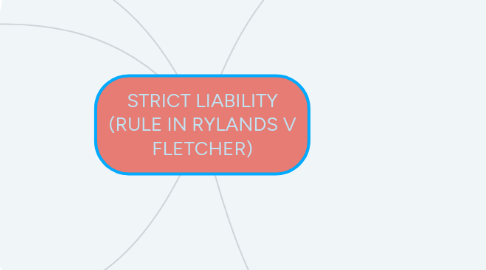
1. WHO CAN SUE
1.1. The plaintiff must have some interest in the land that is affected.
2. WHO CAN BE SUED
2.1. The defendant must be the occupier who is in control of the land.
3. DEFENCES
3.1. Consent
3.1.1. The rule does not apply to the escape of things brought by the defendant onto his premises with the consent of the plaintiff.
3.1.2. In such cases, the plaintiff will be limited to an action in negligence: VICTOR WESTON LTD v KENNY
3.1.3. The most common application of this defence is in the situation where water escapes on the upper storey of a building with several tenants.
3.2. Act of Stranger
3.2.1. Case: PERRY v KENDRICKS TRANSPORT LTD
3.2.2. The plaintiff must show “that the defendants reasonably should have anticipated an act of a kind which would cause the escape.”
3.3. Act of God
3.3.1. Case: TENNENT v EARL OF GLASLOW
3.3.2. “An event which no human foresight can provide against, and of which human prudence is not bound to recognize the possibility.”
3.4. Default of the Plaintiff
3.4.1. Case: DUNN v BIRMINGHAM CANAL NAVIGATION
3.5. Statutory Authority
3.5.1. In some instances a statute may authorize the defendant to act in a manner that would involve liability under Rylands v Fletcher.
4. RYLANDS V FLETCHER
4.1. The defendant employed independent contractors to construct a reservoir on their land.
4.2. The contractors found disused mineshaft when digging but believed it was filled with earth and failed to seal them properly. They filled the reservoir with water.
4.3. Unknown to the defendant or the contractors, this mineshaft connected to the claimant’s coalmine on neighbouring land.
4.4. As a result, water flooded through the mineshafts into the plaintiff's mines on the adjoining property.
4.5. The defendant had not been negligent, as he had trusted the independent contractors, yet he was liable for the damage to the claimant’s land.
4.6. The plaintiff secured a verdict at Liverpool Assizes. The Court of Exchequer Chamber held the defendant liable and the House of Lords affirmed their decision
5. ELEMENTS
5.1. Defendant Brought Something onto His Land
5.1.1. Accumulation - The defendant must bring something onto his or her land for his or her own purposes that does not naturally occur there. The rule does not apply to things i.e. natural accumulation.
5.1.1.1. Case: -CROWHURST v AMERSHAM BURIAL BOARD -PONTING v NOAKES
5.2. Non-natural Use
5.2.1. Case: RICKARDS v LOTHIAN
5.2.1.1. Non-natural: “There must be some special use bringing with it increased danger to others and it must not be merely be the ordinary use of land or such a use as is proper for the general benefit of the community”.
5.3. Likely to Do Mischief
5.3.1. Case: HALE v JENNINGS, the proprietor of a chair O'plane was liable for the escape of a chair caused by a passenger tempering with it which cause the plaintiff to suffer injury.
5.3.2. 1.Escape
5.3.2.1. “Escape from a place where the defendant has occupation or control over land to a place which is outside his occupation or control” – Per Viscount Simon.
5.3.2.2. Case: READ v LYONS, this claim under the rule in Rylands v Fletcher failed because the dangerous thing did not escape.
5.3.3. 2. Foreseeability of Damage
5.3.3.1. The normal rules of causation apply, in that the damage must be reasonably foreseeable.
5.3.3.2. Case: CAMBRIDGE WATER CO. v EASTERN COUNTIES LEATHER

